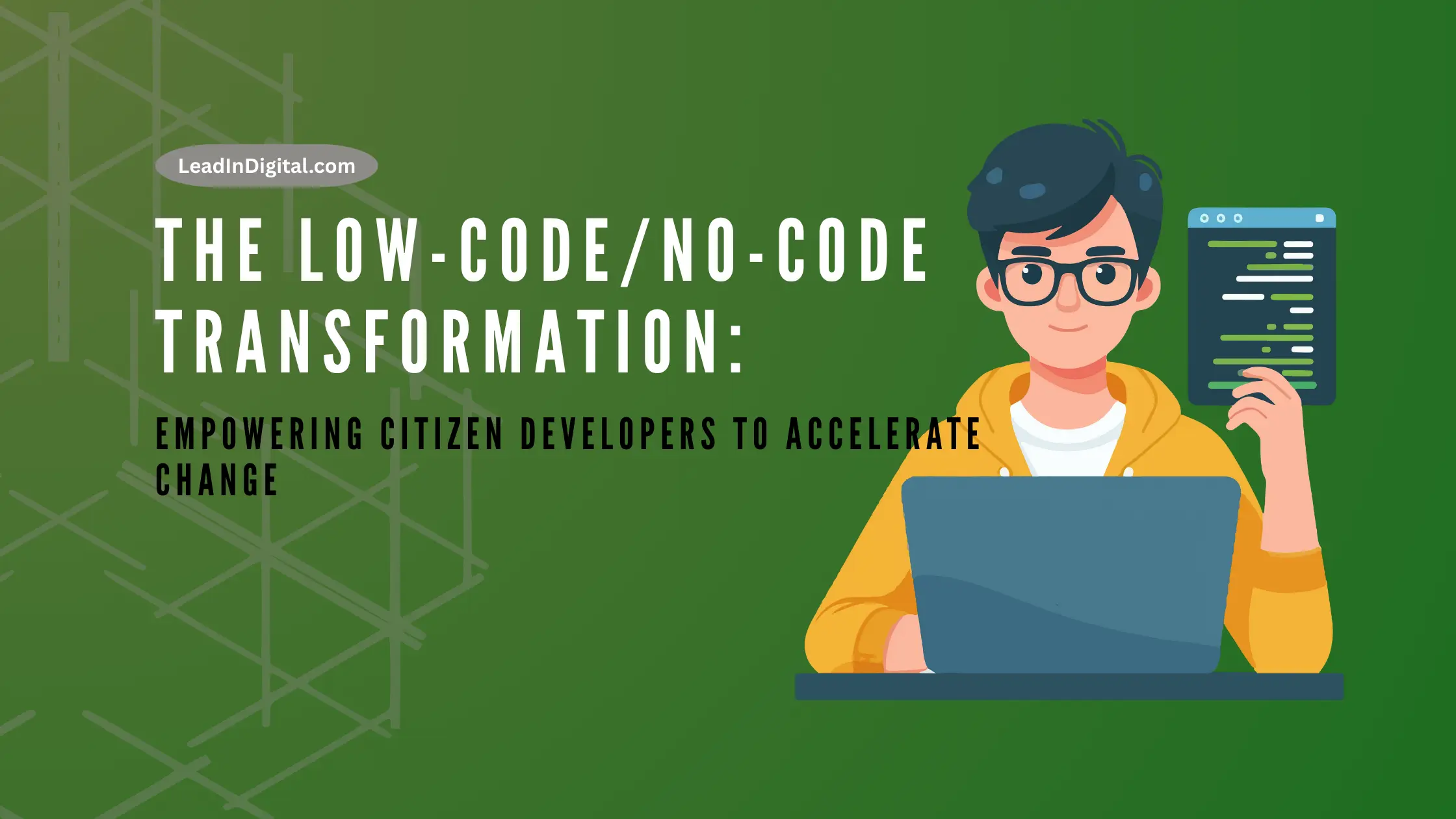
Understanding Low-Code/No-Code Development
Both low-code and no-code tools minimize or eliminate traditional hard coding, enabling rapid application creation through visual interfaces, drag-and-drop components, and pre-built templates.
| Feature | Low-Code | No-Code |
|---|---|---|
| Target Users | Developers, tech-savvy business users | Business users, non-technical staff |
| Customization Level | Moderate to high | Limited, based on templates |
| Coding Required | Minimal | None |
| Use Cases | Enterprise apps, integrations, backend automation | Internal tools, forms, workflows |
| Example Tools | Mendix, OutSystems, Microsoft Power Apps | Airtable, Bubble, Glide, Zapier |
The Rise of the Citizen Developer
A citizen developer is a business user who creates applications using IT-sanctioned low-code or no-code tools. These users understand business processes intimately and can now directly build tools to optimize them without relying on expensive IT teams.
Key drivers behind this rise include:
Digital-first business models: Companies need rapid adaptability.
IT skill shortages: Demand for developers far exceeds supply.
Tool accessibility: Modern LCNC platforms are highly intuitive.
Remote collaboration trends: Cloud-based platforms foster team-based innovation.
According to Gartner, by 2026, 80% of technology products and services will be built by non-IT professionals, signifying a massive cultural and operational shift.
Why Businesses Are Embracing LCNC Platforms
Organizations are rapidly integrating LCNC technologies because they directly address long-standing business pain points.
1. Accelerated Innovation
Traditional software projects can take months or years. Low-code tools accelerate prototyping and iteration, enabling teams to deliver working applications in days.
2. Reduced IT Backlogs
By empowering non-developers, IT teams can redirect focus toward complex, mission-critical initiatives instead of routine automation requests.
3. Cost Efficiency
Faster development cycles mean reduced labor hours and quicker ROI.
4. Improved Business-IT Alignment
Citizen developers bring business context; IT provides governance creating a collaborative ecosystem that aligns innovation with strategy.
5. Greater Agility
Low-code and no-code platforms thrive on adaptability. As market needs evolve, apps can be easily updated or scaled without deep technical overhauls.
Real-World Applications of Low-Code/No-Code
Low-code and no-code platforms are already driving impactful digital transformation across industries.
Finance:
Automating loan processing, customer data management, and KYC workflows.
Healthcare:
Creating patient intake forms, appointment scheduling, and telehealth dashboards.
Retail:
Building inventory management systems and personalized e-commerce experiences.
Education:
Developing learning management dashboards, feedback automation, and admission forms.
Manufacturing:
Designing predictive maintenance apps and supply chain tracking tools.
The Evolving Role of IT in the LCNC Era
While LCNC tools empower business users, they don’t eliminate the need for developers or IT oversight. Instead, roles evolve.
IT Professionals Now Focus On:
Governance and compliance frameworks
Secure integration between citizen-built and enterprise-grade apps
Managing API connectivity and interoperability
Extending LCNC apps through advanced coding where needed
Rather than losing control, IT departments act as strategic enablers, ensuring design governance while accelerating innovation safely.
Benefits for Citizen Developers
Citizen developers aren’t replacing IT, they’re extending it. Their empowerment drives organizational agility.
Top Benefits Include:
Building solutions that directly meet user needs.
Reducing workflow inefficiencies without waiting for IT resources.
Gaining digital skills and confidence through visual, intuitive tools.
Improvising business processes quickly as challenges arise.
This democratization bridges the gap between technical capability and business innovation.
Challenges and Risks to Address
Despite clear advantages, the LCNC revolution brings several challenges that organizations must proactively address.
| Challenge | Description | Solution |
|---|---|---|
| Governance | Risk of shadow IT or uncontrolled app sprawl | Establish central approval workflows |
| Security & Compliance | Data vulnerabilities due to poor design | Implement IT-managed security protocols |
| Integration | Connecting citizen-built apps with enterprise systems | Use secure APIs and integration templates |
| Quality Assurance | Lack of testing or scalability issues | Introduce standard QA processes for citizen apps |
| Change Management | Resistance from traditional developers | Foster collaboration and recognize new roles |
Key Low-Code/No-Code Platforms Shaping the Market
There are dozens of LCNC tools available, catering to diverse needs, from app development to automation and data visualization.
| Platform | Type | Core Focus | Ideal For |
|---|---|---|---|
| Microsoft Power Apps | Low-Code | App creation within Microsoft ecosystem | Enterprises using Microsoft 365 |
| Mendix | Low-Code | Scalable enterprise apps | Large-scale transformation projects |
| OutSystems | Low-Code | Full-stack development platform | Complex enterprise systems |
| Bubble | No-Code | Web app builder | Startups and SMBs |
| Airtable | No-Code | Database + collaboration | Marketing, project management |
| Zapier | No-Code | Workflow and automation | Seamless app integration |
| AppSheet | No-Code | Mobile and data-driven apps | Google Workspace users |
The Future of Application Development
The LCNC revolution signals a future where innovation is collaborative, visual, and accessible. As AI and automation merge with LCNC ecosystems, expect development processes to become even smarter.
Emerging Trends Include:
AI-assisted app building through prompt-based interfaces.
Auto-generation of business logic with natural language processing.
Integration with enterprise AI tools for predictive analytics.
Multi-experience design (web, mobile, chatbots) through unified platforms.
Expansion of composable enterprise structures using LCNC blocks.
The synergy between AI-powered automation and citizen development will redefine how organizations innovate at scale.
Empowering a Culture of Continuous Innovation
Low-code/no-code is much more than a development approach it’s a philosophy of empowerment. It cultivates a mindset where every team member becomes an agent of innovation.
To successfully adopt LCNC, companies should:
Create internal training programs for citizen developers.
Build IT governance frameworks without stifling creativity.
Integrate LCNC tools into the organization’s digital strategy.
Encourage experimentation and reward successful implementations.
When executed thoughtfully, LCNC becomes a cultural shift that transforms not just technology but also the way people work, collaborate, and invent.
Case Study: Transforming Business Outcomes
Scenario:
A mid-sized logistics company faced persistent IT backlogs and manual operational inefficiencies.
Challenges:
Slow application delivery cycles
Limited IT capacity
Disconnected workflows
LCNC Solution:
The firm adopted Microsoft Power Apps to build internal workflow tools. Citizen developers mostly operations managers designed shipment tracking dashboards and automated approval systems in under six weeks.
Results:
60% reduction in manual data entry
40% faster workflow turnaround
Enhanced transparency and collaboration across departments
This example underscores how empowering non-technical employees can yield measurable transformation quickly and cost-effectively.
Looking Ahead: A Hybrid Future
The future of enterprise development lies in a hybrid model, combining low-code/no-code capabilities with traditional software engineering.
Key Characteristics of This Hybrid Model:
Business users focus on front-end workflows.
Developers handle integrations, data governance, and advanced functionalities.
AI tools bridge complexity by automating code generation or documentation.
By leveraging the strengths of both sides, organizations achieve agility without sacrificing robustness.
Conclusion
The low-code/no-code transformation represents one of the most significant shifts in digital innovation since the dawn of cloud computing. It empowers everyday professionals citizen developers to create meaningful solutions that enhance productivity, strengthen collaboration, and fuel digital growth.
As boundaries between developers and business users blur, enterprises that embrace LCNC early will build a lasting competitive edge anchored in speed, creativity, and inclusiveness.
The message is clear: the power to innovate no longer belongs solely to IT departments it’s in everyone’s hands.




